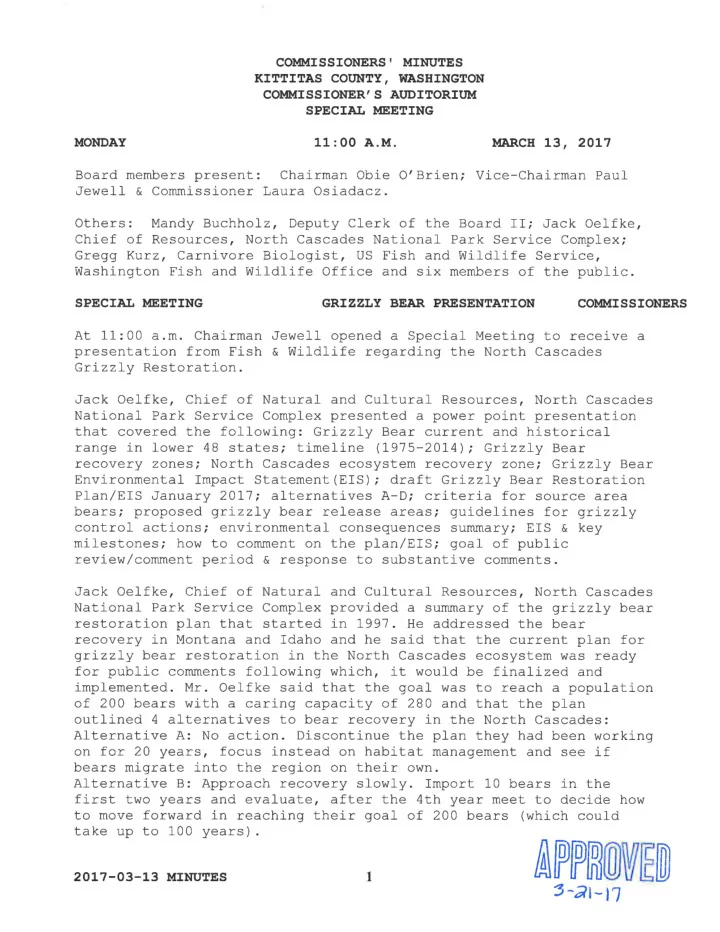

COMMISSIONERS' MINUTES KITTITAS COUNTY, WASHINGTON COMMISSIONER'S AUDITORIUM SPECIAL MEETING MONDAY 11:00 A.M. MARCH 13, 2017 Board members present: Chairman Obie O'Brien; Vice-Chairman Paul Jewell & Commissioner Laura Osiadacz. Others: Mandy Buchholz, Deputy Clerk of the Board II; Jack Oelfke, Chief of Resources, North Cascades National Park Service Complex; Gregg Kurz, Carnivore Biologist, US Fish and Wildlife Service, Washington Fish and Wildlife Office and six members of the public. SPECIAL MEETING GRIZZLY BEAR PRESENTATION COMMISSIONERS At 11:00 a.m. Chairman Jewell opened a Special Meeting to receive a presentation from Fish & Wildlife regarding the North Cascades Grizzly Restoration. Jack Oelfke, Chief of Natural and Cultural Resources, North Cascades National Park Service Complex presented a power point presentation that covered the following: Grizzly Bear current and historical range in lower 48 states; timeline (1975-2014); Grizzly Bear recovery zones; North Cascades ecosystem recovery zone; Grizzly Bear Environmental Impact Statement (EIS) ; draft Grizzly Bear Restoration Plan/EIS January 2017; alternatives A-D; criteria for source area bears; proposed grizzly bear release areas; guidelines for grizzly control actions; environmental consequences summary; EIS & key milestones; how to comment on the plan/EIS; goal of public review/comment period & response to substantive comments. Jack Oelfke, Chief of Natural and Cultural Resources, North Cascades National Park Service Complex provided a summary of the grizzly bear restoration plan that started in 1997. He addressed the bear recovery in Montana and Idaho and he said that the current plan for grizzly bear restoration in the North Cascades ecosystem was ready for public comments following which, it would be finalized and implemented. Mr. Oelfke said that the goal was to reach a population of 200 bears with a caring capacity of 280 and that the plan outlined 4 alternatives to bear recovery in the North Cascades: Alternative A: No action. Discontinue the plan they had been working on for 20 years, focus instead on habitat management and see if bears migrate into the region on their own. Alternative B: Approach recovery slowly. Import 10 bears in the first two years and evaluate, after the 4th year meet to decide how to move forward in reaching their goal of 200 bears (which could take up to 100 years). 2017-03-13 MINUTES 1
Alternative C: Import 25 bears & monitor them noting it could take 60 - 100 years to reach a population of 200 bears. Alternative D: Import 5 - 7 bears a year for as long as it takes to reach 200 bears through natural means. This would take approximately 25 years. Mr. Oelfke informed the Commissioners that since this plan was an experiment, they had greater flexibility within it for managing any bears that came into conflict with farmers, miners, and those in forestry. He said a management plan would be worked on once the grizzly restoration plan was completed. He said that the primary source of bear population would be coming from British Columbia and Montana where there are healthy bear populations that feed on food sources that the North Cascades also had: berries, grubs and small mammals. He said that not a lot of bears feed on fish. Mr. Oelfke discussed the environmental consequences of whether or not bears were reintroduced to the North Cascades. He said the bears would see benefits, black bears would be impacted minimally, the recreational experience would be impacted positively, there was low potential for bear/human conflict, low potential for impacts to agriculture, livestock, and mining, and positive impacts for the tribes. There was roundtable Q&A between the Board members and Jack Oelfke, Chief of Resources, North Cascades National Park Service Complex & Gregg Kurz, Carnivore Biologist, US Fish and Wildlife Service, Washington Fish and Wildlife Office. There was discussion on the caring capacity and the analysis done on the caring capacity. Mr. Oelfke said that comments regarding the grizzly bear restoration plan, and which of the 4 alternatives were preferred, were being accepted through a "new" deadline of April 28, 2017. He stated that implementation would be at a minimum of a year if not longer. He said the plan could be found at www.parkplanning.nps.gov/grizzlydeis. The Board thanked Mr. Oelfke and Mr. Kurz for agreeing to attend the meeting and apologized that none of them were able to make it to the presentation they did in the Upper County in February due to scheduling conflicts. The Board indicated that they would prepare a response in the near future to be considered as part of the record. Meeting adjourned at 12:10 p.m. KITTITAS COUNTY COMMISSIONERS DEPUTY CLERK OF THE BOARD KITTITAS COUNTY, WASHINGTON 2017-03-13 MINUTES 2
~ ChairmaD 2017-03-13 MINUTES 3
Recommend
More recommend